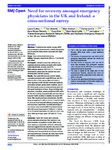Need for recovery amongst emergency physicians in the UK and Ireland: a cross-sectional survey
| dc.contributor.author | Cottey, L | |
| dc.contributor.author | Roberts, T | |
| dc.contributor.author | Graham, B | |
| dc.contributor.author | Horner, D | |
| dc.contributor.author | Stevens, Kara | |
| dc.contributor.author | Enki, D | |
| dc.contributor.author | Lyttle, MD | |
| dc.contributor.author | Latour, Jos M | |
| dc.date.accessioned | 2020-11-02T13:44:27Z | |
| dc.date.issued | 2020-11-02 | |
| dc.identifier.issn | 2044-6055 | |
| dc.identifier.issn | 2044-6055 | |
| dc.identifier.other | e041485 | |
| dc.identifier.uri | http://hdl.handle.net/10026.1/16617 | |
| dc.description.abstract |
<jats:sec><jats:title>Objectives</jats:title><jats:p>To determine the need for recovery (NFR) among emergency physicians and to identify demographic and occupational characteristics associated with higher NFR scores.</jats:p></jats:sec><jats:sec><jats:title>Design</jats:title><jats:p>Cross-sectional electronic survey.</jats:p></jats:sec><jats:sec><jats:title>Setting</jats:title><jats:p>Emergency departments (EDs) (n=112) in the UK and Ireland.</jats:p></jats:sec><jats:sec><jats:title>Participants</jats:title><jats:p>Emergency physicians, defined as any registered physician working principally within the ED, responding between June and July 2019.</jats:p></jats:sec><jats:sec><jats:title>Main outcome measure</jats:title><jats:p>NFR Scale, an 11-item self-administered questionnaire that assesses how work demands affect intershift recovery.</jats:p></jats:sec><jats:sec><jats:title>Results</jats:title><jats:p>The median NFR Score for all 4247 eligible, consented participants with a valid NFR Score was 70.0 (95% CI: 65.5 to 74.5), with an IQR of 45.5–90.0. A linear regression model indicated statistically significant associations between gender, health conditions, type of ED, clinical grade, access to annual and study leave, and time spent working out-of-hours. Groups including male physicians, consultants, general practitioners (GPs) within the ED, those working in paediatric EDs and those with no long-term health condition or disability had a lower NFR Score. After adjusting for these characteristics, the NFR Score increased by 3.7 (95% CI: 0.3 to 7.1) and 6.43 (95% CI: 2.0 to 10.8) for those with difficulty accessing annual and study leave, respectively. Increased percentage of out-of-hours work increased NFR Score almost linearly: 26%–50% out-of-hours work=5.7 (95% CI: 3.1 to 8.4); 51%–75% out-of-hours work=10.3 (95% CI: 7.6 to 13.0); 76%–100% out-of-hours work=14.5 (95% CI: 11.0 to 17.9).</jats:p></jats:sec><jats:sec><jats:title>Conclusion</jats:title><jats:p>Higher NFR scores were observed among emergency physicians than reported in any other profession or population to date. While out-of-hours working is unavoidable, the linear relationship observed suggests that any reduction may result in NFR improvement. Evidence-based strategies to improve well-being such as proportional out-of-hours working and improved access to annual and study leave should be carefully considered and implemented where feasible.</jats:p></jats:sec> | |
| dc.format.extent | 0-0 | |
| dc.format.medium | Electronic | |
| dc.language | en | |
| dc.language.iso | en | |
| dc.publisher | BMJ Publishing Group | |
| dc.subject | accident & | |
| dc.subject | emergency medicine | |
| dc.subject | health services administration & | |
| dc.subject | management | |
| dc.subject | human resource management | |
| dc.subject | organisation of health services | |
| dc.subject | occupational & | |
| dc.subject | industrial medicine | |
| dc.title | Need for recovery amongst emergency physicians in the UK and Ireland: a cross-sectional survey | |
| dc.type | journal-article | |
| dc.type | Journal Article | |
| dc.type | Research Support, Non-U.S. Gov't | |
| plymouth.author-url | https://www.webofscience.com/api/gateway?GWVersion=2&SrcApp=PARTNER_APP&SrcAuth=LinksAMR&KeyUT=WOS:000584947700001&DestLinkType=FullRecord&DestApp=ALL_WOS&UsrCustomerID=11bb513d99f797142bcfeffcc58ea008 | |
| plymouth.issue | 11 | |
| plymouth.volume | 10 | |
| plymouth.publication-status | Published | |
| plymouth.journal | BMJ Open | |
| dc.identifier.doi | 10.1136/bmjopen-2020-041485 | |
| plymouth.organisational-group | /Plymouth | |
| plymouth.organisational-group | /Plymouth/Faculty of Health | |
| plymouth.organisational-group | /Plymouth/Faculty of Health/School of Nursing and Midwifery | |
| plymouth.organisational-group | /Plymouth/REF 2021 Researchers by UoA | |
| plymouth.organisational-group | /Plymouth/REF 2021 Researchers by UoA/UoA03 Allied Health Professions, Dentistry, Nursing and Pharmacy | |
| plymouth.organisational-group | /Plymouth/Research Groups | |
| plymouth.organisational-group | /Plymouth/Research Groups/Institute of Health and Community | |
| plymouth.organisational-group | /Plymouth/Research Groups/Plymouth Institute of Health and Care Research (PIHR) | |
| plymouth.organisational-group | /Plymouth/Users by role | |
| plymouth.organisational-group | /Plymouth/Users by role/Academics | |
| plymouth.organisational-group | /Plymouth/Users by role/Researchers in ResearchFish submission | |
| dc.publisher.place | England | |
| dcterms.dateAccepted | 2020-09-21 | |
| dc.rights.embargodate | 2020-11-3 | |
| dc.identifier.eissn | 2044-6055 | |
| dc.rights.embargoperiod | Not known | |
| rioxxterms.funder | National Institute for Health Research | |
| rioxxterms.identifier.project | NIHR Academic Clinical Fellowship | |
| rioxxterms.versionofrecord | 10.1136/bmjopen-2020-041485 | |
| rioxxterms.licenseref.uri | http://www.rioxx.net/licenses/all-rights-reserved | |
| rioxxterms.licenseref.startdate | 2020-11-02 | |
| rioxxterms.type | Journal Article/Review | |
| plymouth.funder | NIHR Academic Clinical Fellowship::National Institute for Health Research |


